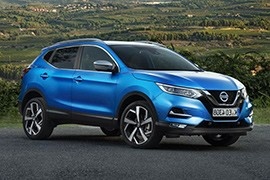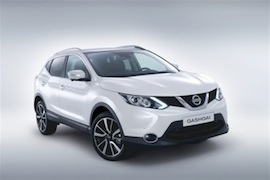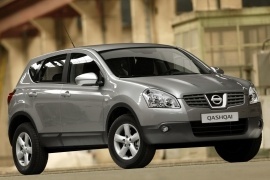
NISSAN Qashqai
Generations Timeline, Specs and Pictures

Nissan unveiled the third generation of its compact SUV Qashqai at the beginning of 2021, and it showed a completely new design language for the Japanese brand.
In 2007, Nissan surprised the market with the first generation of the Qashqai. It was a revolutionary vehicle for the Japanese carmaker, who offered the compact SUV as an alternative for the compact station wagons. Thanks to Nissan’s experience in 4x4 vehicles, the Qashqai quickly became one of the best-selling vehicles in its segment and proved to be a trustworthy partner for its customers.
The 2021 model was built on the CMF-C Alliance platform shared with the Nissan Rogue and Mitsubishi Outlander. Its front grille with an enlarged V-shaped chromed trim was a clear feature for the Nissan brand. With the fourth generation, the Qashqai displayed a different light signature with the LED daytime running lights at the top and then the slim LED headlights underneath. Its bold look was a clear statement for the successful car, which was sold in over three million units worldwide in its previous generations.
Inside, Nissan sent the Qashqai into the new technology age with the introduction of the 9” touch-screen display for the infotainment system and a 12.3” TFT display in the instrument cluster. In addition to these, Nissan introduced a 10.8” Head-up Display that showed all the necessary information projected on the windscreen.
Under the hood, the carmaker introduced the e-Power version that was based on a gasoline engine and an electric motor. The rest of the range was filled with mild-hybrid versions powered by a 1.3-liter turbocharged gasoline engine. There are no turbo-diesel versions anymore.

The best-selling crossover in Europe, Nissan’s Qashqai is also the Japanese carmaker’s most successful model in Europe in all of its 83-year old history.
The second generation was not exactly due for a mid-cycle facelift, since it continued to have an unrivaled market share, however, Nissan decided to produce one anyway.
The biggest changes for the facelift are found on the exterior, which now features an integrated front bumper as standard, with vents on each side aiding engine cooling. The updated front end is also adorned with the latest evolution of Nissan’s “V-motion” grille, which accompanies two new versions of the Nissan badge, depending on whether the model is fitted with Intelligent Emergency Braking (IEB) or not. New headlamp clusters with a redesigned “boomerang” Daytime Running Lamp signature complete the revamp.
The Qashqai won the hearts of its buyers due to its multiple qualities. The trunk space was one of the biggest in its class. The load capacity was 430 liters, so it was ideal for a family getaway. The rear seats were foldable, increasing the load capacity at 1596 liters. The cabin itself was a roomy one, with enough leg space for the passengers in the back, as well as enough huge headroom for everybody in the car.
Safety was not disregarded and important features are available for the standard trim level: auto emergency braking, forward collision warning and lane departure warning. The rear parking sensors and the reversing camera was still present, carried over from its predecessor.

This is the leader of the compact-SUV segment in Europe.
Its affordable purchase price, very good brand image and good vehicle abilities made it a top seller. Over 2 million units were sold in just five years of production. It was helped by the SUV trend, but also the other manufacturers could sell more. But they didn’t like the Qashqai did it.
Without a very bold look and more like a domestic appliance, the Qashqai conquered market aftermarket with its serene exterior look, good trim levels and spacious interior. The full LED headlights for the upper trim levels were a bonus. In 2013 not too many manufacturers were offering such an option, apart from the premium segment.
Inside, the Qashqai’s combines innovative technologies with common sense solutions to everyday challenges. The seats, for instance, were designed using advanced medical scanning techniques and were inspired by NASA to analyze pressure and blood flow in the lower back of seated passengers. The comfort made the car sell even better.
Under the hood, there were six gasoline engines offered and only two types of diesel. A six-speed manual or a CVT was offered for the transmission. Since the demand for 2wd was higher than that for 4wd in Western Europe, some of the engines were not even available with the intelligent 4x4 traction.

The first generation of the Nissan Qashqai was a huge success on the European market.
The car maker experience in the 4x4 segment payed off. In 2010, the car went through a major facelift.
The first generation of the Nissan Qashqai landed on the market when the automotive industry was hit hard by the world economic crisis. Despite the odds, the Japanese compact SUV was well received by the market and it was sold in high numbers. The sales started in 2007 and by the time the world economy was still suffering from the crisis, the little Qashqai exceeded 200.000 units per year. After the 2010 facelift, the numbers jumped again over 300.000 units mark.
Qashqai received an ample boost of image with the introduction of the mid-life cycle refresh. A new front fascia, with a more dynamic look was far more appealing for customers. The grille, and the hood, were refreshed too. In the back, LED taillights were installed instead of the regular light bulbs.
Inside, the Qashqai offered room for up to seven passengers in the +2 version, which featured a longer wheelbase. The basic equipment was decent and it even featured standard Bluetooth connectivity with the audio system. The on-board computer received a white LCD screen placed between the tachometer and the speedometer.
For the engine bay, the car lost its previously used 2.0-liter turbodiesel engines and new, 1.6-liter units were installed. Even though they lost some horses on the way, the torque was the same but at lower rpms, which enhanced the fuel efficiency.

Named after a nomadic Persian tribe, Nissan’s compact crossover SUV claims to be urbanproof.
More than suitable for city use due its good suspension, elevated ground clearance and soundproofing, Qashqai’s stamina is fueled through a choice of engines ranging in capacity from 1.5 L to 2.0 L. Available in both 2 and 4-wheel drive modes coupled with a standard 6-speed manual transmission or an optional CVT one, the Qashqai seems to be the wheeled corespondent of a Persian wild horse. Stylish and reliable, the car is also safe having scored maximum points during last year’s EuroNCAP tests.























































